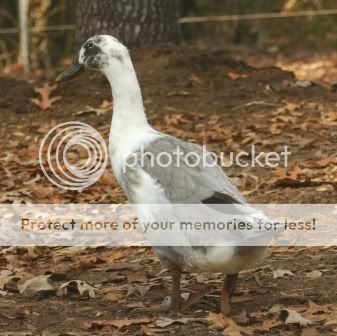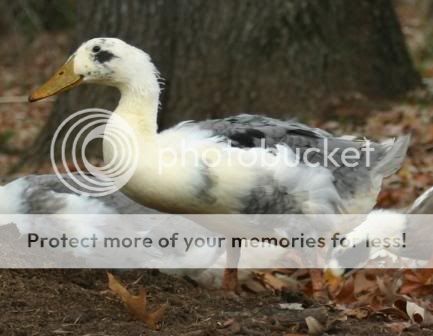I will make suggestions, but FIRST and FOREMOST, I recommend buying Dave Holderread's Ancona Breed Standard book. Until you read and interpret it yourself, you can't be sure what you're doing. Also, buy "Storey's Guide to Raising Ducks" unless you have a firm grasp of waterfowl color/pattern genetics.
m.kitchengirl: From what I understand of the standard and from what I can see in the picture. I'd say he's a pretty good representative. He has nice, splotchy markings - ie. genetically E/e, whereas Magpie-type patterns are E/E. Also, he looks to be a sturdy, heavy, wide boy which is a plus. Remember this is a dual purpose breed, the males need to big and muscled enough to make a good roaster. Lastly, he has markings on his face - under his eyes, on his chest, on his feet, and none on the neck, this is good. The only addition to his color you'd want to see is spots on the bill. Overall, he looks like a nice boy. calm temperament and good foraging skills also weigh heavily but I can't judge that based on a photo.
Per Dave Holderread, the colors are defined as:
Black/White - E/E (magpie type pattern), E/e (wildly-marked pattern)
It is understood that the ideal Ancona pattern is achieved with the E/e variant so I will only refer to it with the rest of the colors, though the double-E is possible in all. Also, we are only discussing colors not patterns so I've left off the rest of the genetics dealing with pattern.
Chocolate/White - E/e, d/
d (dark brown w/ green sheen) OR E/e, d/
d, bu/
bu (light brown, no green sheen, rare)
Blue/White - E/e, Bl/bl
Lavender/White - E/e, Bl/Bl, d/
d
(Lavender is therefore Blue and Chocolate acting together)
Silver/White - E/e, Bl/Bl
(Similar to the Black,Blue, Splash relationship in chickens)
"Because the best-marked individuals carry a single extended black gene, blacks and blues (especially the drakes) often have a reddish-brown shading in the colored portions of their plumage. This "rust" is a fault in all other patterns, but is a characteristic of the broken pattern." [Storey's Guide to Raising Ducks; Dave Holderread]
ToadBriar: This rusting referred to above is what your lavender drake is exhibiting. That's why you see the brown showing up. True tri-colors have specific feathers that are solidly colored (distinct from birth). I would like to use your photo on my website to demonstrate rusting if possible. I can't get any good photos of mine to show. PM me and let me know if that's alright.
Here's a few examples of tri-colors.:
Adult Duck
Duckling - in the front-center you can see a blue baby with a black spot on its tail
Same duckling as young drake
I have yet to figure out what's going on genetically with tri-colors and therefore how to breed for it, but I'm hoping to hear back from Dave H. before next Spring.
Hope all of this helps explain things a bit better. If not, well thank goodness I didn't go into teaching, LOL. I know my website has photos and more information, but it's inaccurate at the moment. I need to tweak it. It's still a good reference for the colors though. If ANYONE can get that "beetle green" sheen to show up in a photo, PLEASE let me use it on my site. I know it can be done, since I've seen good photos of Cayugas, but my camera is terrible and shows nothing.



















